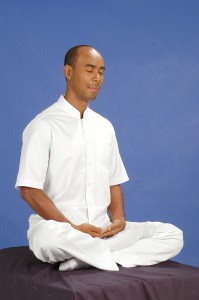Meditating outdoors? Does it really matter where you meditate? I think it can. For some of us, being outside makes for not just a different meditation experience, but a more profound one.  There are some good reasons for this.
There are some good reasons for this.
perhaps meditating in a quiet room with no sounds and nothing to distract is the easiest way, especially for beginners. It’s hard enough to quiet your mind without constant input from your surroundings. On the other hand, life is constant input, so if you want the peacefulness that comes from meditation to enter your life beyond your practice, perhaps learning to meditate despite surrounding sounds and movement is just what you need.
Why Try Meditating Outside?
There’s a high bank on a river where I lived years ago. It was a five-minute walk from the house. There’s a level grassy spot at the top, looking down on the water fifty feet below. That is where I would go to sit. Often there was a breeze I could feel on my skin and hear in the surrounding trees. I also heard the water as it strained through some dead trees near the river bank. I smelled the dirt around me, and the odor of fish coming up from the water.
Meditating there wasn’t only pleasurable because of the environment, but also different from meditating in the silence of my home. There was more of a sense of experiencing the world without thought, without over-analyzing. Why? Perhaps simply because there was more to experience. There were the sounds, which included birds, and the occasional splashing of some animal in the river. There were things to smell and the feel of the grass.
I usually close my eyes when I meditate, because I am a very visually-oriented person, and find it easier to meditate this way. When I finished my meditation by the river, I would open my eyes, of course, but what I saw was always different from what was there when I started. Of course it was the same, but I was seeing it differently, as if for the first time. While difficult to explain, this is easy to recognize if you have had the experience.
It’s wonderful to look around as if seeing for the first time. You are seeing without preconception. I might see a deer on the opposite bank of the river, but the thought “deer” wouldn’t cross my mind, meaning it wouldn’t cloud my vision with any ideas about what a deer is or should be. The sounds and sensations were also “new.” I think this more direct experience of life is a profound demonstration of how much we normally “live” through our thoughts, somewhat detached from reality.
If you haven’t already tried it, why not get outside for your next meditation? Sit on a hill or in front of a garden, or try standing in front of a lake or pond when you meditate. The view will be wonderful when you open your eyes. There is nothing quite like meditating outdoors.
PS: Have you tried out the Mindfulness Mediation App yet? I know that it works for me: http://apple.co/1F7bNAm
 negative, and wandering thoughts and fantasies, and calming the mind with a deep sense of focus. This clears the mind of debris and prepares it for a higher quality of activity.
negative, and wandering thoughts and fantasies, and calming the mind with a deep sense of focus. This clears the mind of debris and prepares it for a higher quality of activity.